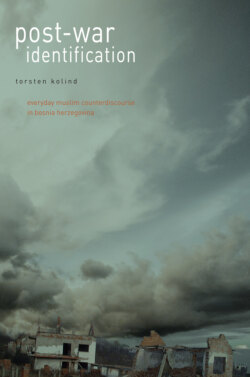Читать книгу Post-War Identification - Torsten Kolind - Страница 11
На сайте Литреса книга снята с продажи.
Introduction
ОглавлениеThe war in former Yugoslavia – mainly Croatia and Bosnia Herzegovina – and the fierceness with which it was carried out is probably still remembered by most Europeans. For many, this war inside Europe destroyed the feeling of living in a peaceful region, a feeling built upon a common European commitment to not letting the Second World War repeat itself: Never again! Some, though, succeeded in upholding the idea of everlasting European peace by ascribing the war and violence in former Yugoslavia to an endemic Balkan mentality: the Other within.
The war is now over, at least it officially ended with the Dayton agreement on 14 December 1995, and the people of the region are now trying to piece together a life – pieces consisting of war-related traumas, nationalist propaganda, ruined economies, disappointment, memories of pre-war life and so on. This book focuses on this puzzle of post-war life among the Muslim population of Stolac, a small town in Bosnia Herzegovina. More specifically, I will concentrate on how in everyday practices and narratives the Muslims of Stolac resist the ethnonationalist discourse that has invaded so many aspects of both public and private life throughout the last two decades. Their resistance is seldom outspoken, consciously articulated or organised; rather it consists of a steady insistence on not using ethnic or national categories and stereotypes when identifying themselves and others. And it exists in a hope for future inter-ethnic coexistence. I term this resistance counterdiscourse.
Many books and articles dealing with the war and pre-war period in former Yugoslavia have been published in the last fifteen years, and nearly all of these have analysed the role of nationalism. Some maintain that nationalist or ethnic tensions in former Yugoslavia ignited the war; others have demonstrated how such tensions were produced throughout the war and pre-war period to legitimise a fight for power. Hardly any, however, have focused on how ordinary people trying to hold on to everyday life have related to the discourses of nationalism outside the public sphere.1 In this book I maintain this ethnographic focus; and, as my results illustrate, nationalist policy and ethnic identity and stereotypes in the light of the everyday life of the Muslims of Stolac come to mean something else and also something less, as they have to live with the consequences of ethnic hatred in a much more direct way. My analysis thus partly contradicts structuralist theories of violence, claiming that violence results in the creation of unambiguous and clear-cut identities. By relating such an argument to the way in which actual victims of violence react to the creation of unambiguous identities, one sees that complexity, flexibility and inconsistent categories are what mark post-war/post-violence society.
Because the complex question of ethnicity and nationality in former Yugoslavian republics is so central for understanding both war and post-war life, I shall provide a short explanation:
1) In the former Yugoslavia, everyone had a Yugoslav citizenship.
2) In the former Yugoslavia, one could choose a national identity from the options given by the state, for example on census forms. However, the English term ‘national identity’ or ‘nation’ does not fully cover the term used in former Yugoslavia: narod. In Danish, my own language, there is a more or less equivalent term: folk (or in German volk). The national identities most relevant for this study are: Croat, Serb, Muslim and Yugoslav.
3) In former Yugoslavia, one had an ethnic or ethnoreligious identity (nacija). I use the terms interchangeably. This identity was more or less ‘inherited’ from one’s parents. Though religious terms are used to designate ethnic identity, one cannot translate nacija as religious identity. In my study, I will be referring to the following ethnic or ethnoreligious identities: Catholic, Orthodox Christian and Muslim. And in general (but not always) Croats are Catholics, Serbs are Orthodox Christians, and Muslims are Muslims.
However, things are and were not as clear-cut as the above divisions indicate. In the book, I do not use the terms ‘national identity’ (narod) and ‘ethnic identity’ (nacija), and nationalism and ethnicisation in an entirely consistent and clearcut manner. In the first place, my informants did not do this either, and in the second place the major aim of nationalist policy was to conjoin the two identities, so that the emotionally deep ethnoreligious identity could strengthen the more arbitrary national identity. This nationalist project did succeed up to a point: when my informants – who are Muslims – referred to a Muslim identity, it was not always obvious whether they were referring to ethnic (nacija) or national identity (narod); and often, it was my sense that they were not certain either. It is necessary to add a further remark on terminology. A ‘Bosnian’ (bosanac) is someone coming from Bosnia Herzegovina no matter what his ethnic affiliation. ‘Bosniak’ (bošnjak) means Bosnian Muslim. However, the terms however have a disputed history, see Chapter 10.
